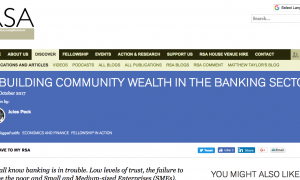
Building Community Wealth in the banking sector
This piece is a blog on the RSA’s website where Jules is a Fellow We all know...
Expert Adviser; Writer; Founding Member of Jericho Chambers

Download Jules' Project Sunlight Pamphlet

In this piece, guest writer Andrew Currey, Head of Futures at The Futures Company, discusses the new report The 21st Century Business, co-authored with Jericho’s Jules Peck, which recently won the 2015 Atticus Strategy award.
Over the last two decades, sustainability has moved from the edge of the business to its heart. There are multiple reasons, but the biggest is that the world has changed. Fundamental shifts in resources, technology and social values, are transforming the business landscape.
Some of these changes are more obvious that others. Every business has adapted, by now, to a world of ubiquitous personal digital technology and devices. Most have taken some steps to reduce energy and resource use and to improve the sustainability of their supply chains. The response to the third big shift, towards well-being (physical and psychological, individual and social) is less well-developed.
But the next stage in sustainability for business is about embracing all three legs of the famous Brundtland definition*: environmental, economic andsocial sustainability. It is this shift that underpins many critiques of market behaviours that were seen in the decades before the financial crisis, and which inform the critiques of markets and capitalism that have been written since.
As Michael Porter and Mark Kramer memorably observed in the Harvard Business Review, “The concept of shared value … recognizes that societal needs, not just conventional economic needs, define markets. It also recognizes that social harms or weaknesses frequently create internal costs for firms.”
In the UK, Geoff Mulgan, CEO of innovation charity, NESTA, argues in his book The Locust and the Bee that we are seeing a shift in the balance of market behaviour towards the creation of new or productive value (the bee) and away from the more extractive value (the locust) that dominated in the years leading up to the financial crisis.
This isn’t just a matter of businesses taking a different view of the world. When the external environment changes, business has to change too. The companies which respond first to the 21st century will gain competitive advantage by being better networked, more open, and more fluid. The reason: it is the best way to serve customers in the new business world.
But the structure and behaviour of many businesses is still shaped by the assumptions of the 20th century – about easy energy and resources, about ‘command and control’ management styles, and attitudes to the purpose of work. Nonetheless, in all sectors, the market leaders are already on a journey to make themselves less inward-looking and more responsive to their external environment.
Our report, The 21st Century Business, co-written with Jules Peck, outlines six significant shifts that will shape these competitive businesses:
The most important of these shifts is the last one, because it connects to the deep social change we are currently seeing towards well-being and ‘Post-Materialist’ values, originally proposed by Ronald Inglehart. Hardin Tibbs, who documented the links between these values and sustainability in a significant article in the Journal of Futures Studies, suggests that in the United States and in Europe we are at the transition point at which half of the population hold these post-materialist values, with the ‘Traditionalist’ and ‘Moderns’ groups slowly shrinking. People with these values, Tibbs notes, “like to think in terms of the whole system, … are concerned about future generations and the fate of the planet, and want to do business with responsible corporations.”
One of the ways we see this change is in a shift in social expression from ‘extrinsic’ or external values to ‘intrinsic’ or internal values. Although on the face of it, companies might think that extrinsically-oriented customers are more attractive – they are more interested in consumption and material display, after all – this would be a mistake.
As Jules Peck notes, an individual with strong extrinsic values “has a lower well-being than others, lowers the well-being of those around them, has a higher than average environmental footprint and is more closed than others to pro-social and environmental behaviour change messaging.” A business that has sustainability objectives involving any kind of behaviour change or sustainable response from customers will fail if its positioning and marketing is directed towards extrinsically-motivated customers.
The 21st century business is being reshaped by a combination of resource pressures, shifting social values and ubiquitous technology. The businesses that win will have redesigned themselves.

A sustainability journey typically starts as a defensive response to a changing business context, stages 1 and 2 on the diagram. At stages 3 and 4 of the journey, we see disruptive innovation that reconfigures current business models and businesses reimagining their markets as being about delivering against real well-being needs rather than creating wants. Taken together, stages 3 and 4 on the matrix represent the 21st century business.

The ‘intrinsic business’ that is talking to customers as citizens, not consumers, is thinking about the whole of its customers’ lives, not just the path to purchase
The same is true of employees. Extrinsically-motivated employees are motivated almost entirely by the deal: salary, bonuses, benefits. They have little loyalty and low levels of commitment. Intrinsically-motivated employees are more likely to respond to the purpose of the work and engage with the business on an emotional level. Since employee engagement is one of the main drivers of performance and profitability, the benefits of being an intrinsically positioned business go straight to the bottom line.
So, the ‘intrinsic business’ that is talking to customers as citizens, not consumers, is thinking about the whole of its customers’ lives, not just the path to purchase. These customers, in turn, expect businesses to help them solve problems rather than simply to sell them something.
With Unilever, for example, one of the goals of Project Sunlight is to build a world “where every home has enough water to drink and to wash, cook and clean.” This means thinking through the impact of personal care products, and others, in the everyday lives of its customers, many of whom live in increasingly water-stressed areas.
The same principles apply in richer parts of the world and in sectors where engagement is regarded as a tougher proposition. In Spain, the supermarket Mercadona has prospered by paying its staff higher wages and training them extensively, while focusing on understanding the needs of its customers. In contrast, others that have concentrated largely on price and logistics have floundered since the financial crisis.
What all of these examples have in common is that sustainability – in its widest sense – has moved out of the corporate affairs department and has become a source of strategic differentiation. Sustainability is rapidly becoming part of business as usual. More importantly, it’s becoming an essential part of competitive advantage.
* From Our Common Future, also known as the Brundtland Report, from the United Nations World Commission on Environment and Development, 1987.
Andrew Curry is a director of WPP’s strategic planning consultancy, The Futures Company.
Jules Peck is a leading expert on sustainable corporate change.
Extract from The 21st Century Business report, written by Andrew Curry and Jules Peck.
Read more at http://thefuturescompany.com/the-21st-century-business/
Copyright 2014 Jules Peck. Jericho Chambers
Leave a Reply